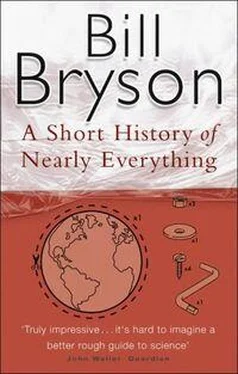In the course of a long career (he lived till 1907 and the age of eighty-three), he wrote 661 papers, accumulated 69 patents (from which he grew abundantly wealthy), and gained renown in nearly every branch of the physical sciences. Among much else, he suggested the method that led directly to the invention of refrigeration, devised the scale of absolute temperature that still bears his name, invented the boosting devices that allowed telegrams to be sent across oceans, and made innumerable improvements to shipping and navigation, from the invention of a popular marine compass to the creation of the first depth sounder. And those were merely his practical achievements.
His theoretical work, in electromagnetism, thermodynamics, and the wave theory of light, was equally revolutionary. [11]He had really only one flaw and that was an inability to calculate the correct age of the Earth. The question occupied much of the second half of his career, but he never came anywhere near getting it right. His first effort, in 1862 for an article in a popular magazine called Macmillan’s , suggested that the Earth was 98 million years old, but cautiously allowed that the figure could be as low as 20 million years or as high as 400 million. With remarkable prudence he acknowledged that his calculations could be wrong if “sources now unknown to us are prepared in the great storehouse of creation”-but it was clear that he thought that unlikely.
With the passage of time Kelvin would become more forthright in his assertions and less correct. He continually revised his estimates downward, from a maximum of 400 million years, to 100 million years, to 50 million years, and finally, in 1897, to a mere 24 million years. Kelvin wasn’t being willful. It was simply that there was nothing in physics that could explain how a body the size of the Sun could burn continuously for more than a few tens of millions of years at most without exhausting its fuel. Therefore it followed that the Sun and its planets were relatively, but inescapably, youthful.
The problem was that nearly all the fossil evidence contradicted this, and suddenly in the nineteenth century there was a lot of fossil evidence.
6 SCIENCE RED IN TOOTH AND CLAW
IN 1787, SOMEONE in New Jersey-exactly who now seems to be forgotten-found an enormous thighbone sticking out of a stream bank at a place called Woodbury Creek. The bone clearly didn’t belong to any species of creature still alive, certainly not in New Jersey. From what little is known now, it is thought to have belonged to a hadrosaur, a large duck-billed dinosaur. At the time, dinosaurs were unknown.
The bone was sent to Dr. Caspar Wistar, the nation’s leading anatomist, who described it at a meeting of the American Philosophical Society in Philadelphia that autumn. Unfortunately, Wistar failed completely to recognize the bone’s significance and merely made a few cautious and uninspired remarks to the effect that it was indeed a whopper. He thus missed the chance, half a century ahead of anyone else, to be the discoverer of dinosaurs. Indeed, the bone excited so little interest that it was put in a storeroom and eventually disappeared altogether. So the first dinosaur bone ever found was also the first to be lost.
That the bone didn’t attract greater interest is more than a little puzzling, for its appearance came at a time when America was in a froth of excitement about the remains of large, ancient animals. The cause of this froth was a strange assertion by the great French naturalist the Comte de Buffon-he of the heated spheres from the previous chapter-that living things in the New World were inferior in nearly every way to those of the Old World. America, Buffon wrote in his vast and much-esteemed Histoire Naturelle , was a land where the water was stagnant, the soil unproductive, and the animals without size or vigor, their constitutions weakened by the “noxious vapors” that rose from its rotting swamps and sunless forests. In such an environment even the native Indians lacked virility. “They have no beard or body hair,” Buffon sagely confided, “and no ardor for the female.” Their reproductive organs were “small and feeble.”
Buffon’s observations found surprisingly eager support among other writers, especially those whose conclusions were not complicated by actual familiarity with the country. A Dutchman named Comeille de Pauw announced in a popular work called Recherches Philosophiques sur les Américains that native American males were not only reproductively unimposing, but “so lacking in virility that they had milk in their breasts.” Such views enjoyed an improbable durability and could be found repeated or echoed in European texts till near the end of the nineteenth century.
Not surprisingly, such aspersions were indignantly met in America. Thomas Jefferson incorporated a furious (and, unless the context is understood, quite bewildering) rebuttal in his Notes on the State of Virginia , and induced his New Hampshire friend General John Sullivan to send twenty soldiers into the northern woods to find a bull moose to present to Buffon as proof of the stature and majesty of American quadrupeds. It took the men two weeks to track down a suitable subject. The moose, when shot, unfortunately lacked the imposing horns that Jefferson had specified, but Sullivan thoughtfully included a rack of antlers from an elk or stag with the suggestion that these be attached instead. Who in France, after all, would know?
Meanwhile in Philadelphia-Wistar’s city-naturalists had begun to assemble the bones of a giant elephant-like creature known at first as “the great American incognitum” but later identified, not quite correctly, as a mammoth. The first of these bones had been discovered at a place called Big Bone Lick in Kentucky, but soon others were turning up all over. America, it appeared, had once been the home of a truly substantial creature-one that would surely disprove Buffon’s foolish Gallic contentions.
In their keenness to demonstrate the incognitum’s bulk and ferocity, the American naturalists appear to have become slightly carried away. They overestimated its size by a factor of six and gave it frightening claws, which in fact came from a Megalonyx, or giant ground sloth, found nearby. Rather remarkably, they persuaded themselves that the animal had enjoyed “the agility and ferocity of the tiger,” and portrayed it in illustrations as pouncing with feline grace onto prey from boulders. When tusks were discovered, they were forced into the animal’s head in any number of inventive ways. One restorer screwed the tusks in upside down, like the fangs of a saber-toothed cat, which gave it a satisfyingly aggressive aspect. Another arranged the tusks so that they curved backwards on the engaging theory that the creature had been aquatic and had used them to anchor itself to trees while dozing. The most pertinent consideration about the incognitum, however, was that it appeared to be extinct-a fact that Buffon cheerfully seized upon as proof of its incontestably degenerate nature.
Buffon died in 1788, but the controversy rolled on. In 1795 a selection of bones made their way to Paris, where they were examined by the rising star of paleontology, the youthful and aristocratic Georges Cuvier. Cuvier was already dazzling people with his genius for taking heaps of disarticulated bones and whipping them into shapely forms. It was said that he could describe the look and nature of an animal from a single tooth or scrap of jaw, and often name the species and genus into the bargain. Realizing that no one in America had thought to write a formal description of the lumbering beast, Cuvier did so, and thus became its official discoverer. He called it a mastodon (which means, a touch unexpectedly, “nipple-teeth”).
Читать дальше












